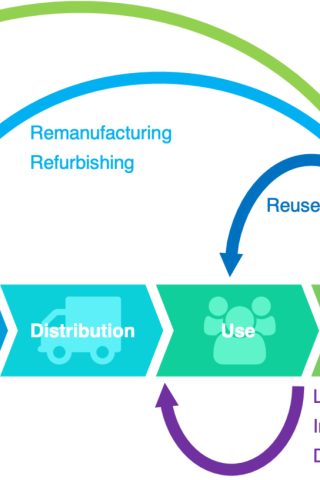Barron’s, By Sarah Max,
Lots of companies have gotten serious about environmental, social, and governance issues in recent years. But few are more surprising than Walmart.
That’s not just because of its sheer size—2.2 million employees, 11,500 retail locations, and revenues that exceed the gross domestic product of most countries—but also because Walmart (ticker: WMT) has long been anathema to socially conscious consumers and investors. Environmentalists bemoaned the company’s massive carbon footprint, gun safety advocates criticized it for selling assault-style rifles, and workplace advocates demanded that it raise its hourly minimum wage.
“They’ve gone from being seen as a problem to becoming a significant part of the solution,” says John Streur, the CEO of Calvert Research and Management, a leader in ESG research and investing.
Early last year, Walmart CEO Doug McMillon began a two-year term as chairman of the Business Roundtable, the CEO trade group that recently said that corporations must act on behalf of all stakeholders, not just shareholders. In Walmart’s 140-page ESG report, McMillon writes, “There are a lot of stereotypes out there about Walmart. It’s no secret to us that we have critics who assume we’re doing business at the expense of people and the planet—that we’re all talk. The fact is, though, we’ve been working hard to use our scale to create positive change for a long time now.”
This shift hasn’t been lost on Wall Street. “Walmart is moving faster and with more purpose and more responsibility for all of its stakeholders, and really it’s trying to evolve and change with the changing times,” says Michael Lasser, who covers Walmart for UBS.
“They’ve gone from being seen as a problem to becoming a significant part of the solution. ”
What’s more, a growing niche on Wall Street has also taken notice: Many fund managers who incorporate sustainable factors into their process have not only taken Walmart off their verboten lists, but have even begun adding the company to their portfolios.
In September 2019, Calvert added the company to its $3.6 billion Calvert US Large Cap Core Responsible Index (CSXAX). Over the past two years, Walmart’s policies and actions—including its response to Covid-19—have been “thesis-confirming” says Leah Moehlig, ESG senior research analyst at Calvert.
To be sure, the world’s largest retailer is a long way from perfect, and Walmart’s ESG conversion, along with much of Corporate America’s, will continue to be met with skepticism. Just for starters, last month, the U.S. Department of Justice filed a lawsuit alleging that Walmart’s in-store pharmacies played a role in fueling the opioid crisis. The company didn’t mince words in its response: “The Justice Department’s investigation is tainted by historical ethics violations, and this lawsuit invents a legal theory that unlawfully forces pharmacists to come between patients and their doctors, and is riddled with factual inaccuracies and cherry-picked documents taken out of context.”
Walmart added that it “always empowered our pharmacists to refuse to fill problematic opioids prescriptions, and they refused to fill hundreds of thousands of such prescriptions.”
The retailer has been far less outspoken about its ESG progress. The company has rather quietly rolled out ambitious environmental initiatives and introduced programs to improve workplace equality and opportunity, support public health, and champion gun safety.
Walmart’s ESG transformation was at least partially awakened by Hurricane Katrina in 2005, when the company played an outsize role in the relief efforts. One of the most prominent features in the lobby of Walmart’s global headquarters in Bentonville, Ark., is a painting of Walmart trucks lined up to bring supplies into New Orleans. A case study from the Harvard Kennedy School of Government points to Walmart’s role in getting food, water, and other resources into flood-stricken areas.
“That really set the company on a different path, which just continued to evolve,” says Kathleen McLaughlin, a onetime director at McKinsey & Co. who joined Walmart in 2013 as the company’s first chief sustainability officer. “It’s really been in the past five or six years that we’ve started to take a more holistic and expansive approach to material ESG issues.”
The investment case for ESG isn’t just about morals; advocates argue that it’s good for business. Many of Walmart’s growth strategies over the past 50 years—more stores and undercutting the competition on price—have probably reached their limit, and now may even be a liability, say fund managers and analysts.
“If you’re a retailer, you’ve got to be worried about reputation, because your relationship with your customer is critical,” says Ingrid Dyott, co-manager of the core equity and sustainable equity strategies at Neuberger Berman. In the digital age, the stakes are higher than ever: Bad news travels quickly, and consumers can take their business elsewhere with the click of a button.
Walmart bulls say that the company’s ESG work is a sign the company has improved its adaptive ways, which is critical as it transitions from a bricks-and-mortar behemoth to an e-commerce leader.
While many traditional retailers have lost ground in the past year, Walmart has thrived. As retail stores were forced to close in March because of the pandemic, Walmart ramped up its same-day delivery, retooled its parking lots to make space for grocery pickup, and hired and trained staff to be personal shoppers. The company is also excelling online, thanks to a digital pivot that began with the $3 billion purchase of Jet.com in 2016. Walmart’s e-commerce sales soared 79% in its November quarter. In September, the company launched Walmart+, a membership program meant to rival Amazon’s Prime.
Analysts are forecasting total Walmart sales of $555 billion when the fiscal year ends this month, up 5.9% from a year earlier. That matches the company’s best growth rate since the 2009 financial crisis. Wall Street sees adjusted earnings rising 13%, to $5.57 a share.
Walmart’s resilience—the stock was down just 15% at its Covid-19 low—makes it a relatively safe play for investors, even as digital growth could spur upside for the stock.
The company’s U.S. digital sales growth has outpaced Amazon.com’s (AMZN) since the onset of Covid-19, says UBS’ Lasser, who says the stock, which recently traded around $145, could reach $165 in the next year.
Despite its resilience during the pandemic, Walmart stock hasn’t rebounded quite like rival Target (TGT), whose stock has doubled from its spring lows. Walmart is up 43%; the stock trades at a somewhat pricey 26 times earnings estimates for the next 12 months, but that’s in line with a 10% premium to the S&P 500 index over the past five years. Over that period, Walmart shares are up 126%, versus 96% for the broad market.
Founded in 1962, Walmart went public in 1970, reaching nearly 2,000 stores three decades later. By 1997, it had $100 billion in annual sales. Yet, the practices that propelled its phenomenal growth left a mark. Critics blamed Walmart for shuttering mom-and-pop businesses and hastening the demise of downtown business corridors. It helped fuel a consumer culture built on cheap goods made overseas and, in the process, created a massive carbon footprint. In 2018, Walmart’s annual carbon emissions related to its direct operations and energy use were 18 million metric tons, down steadily since 2015, but still more than the 11 million metric tons reported by Amazon. These numbers don’t include emissions from indirect sources, such as supply chains or third-party transportation.
Some of Walmart’s most visible alleged infractions have centered on workplace practices; the company has been accused of shutting down unionization efforts, systematically underpaying women, failing to provide workers with adequate health care, and doing business with suppliers with unsafe or inhumane conditions. “Somewhere around the late 1980s and 1990s, there seemed to be a corporate culture shift and just relentless focus on trying to provide lowest-cost products,” Dyott says.
Reputation issues didn’t hurt growth. The company’s stores provided a lifeline for many Americans who relied on the stores’ low prices. For many in rural America, there were few other options available.
Today, the company is acutely aware that it must balance the needs of its customers, shareholders, and the environment. “This is where business in general is going,” says McLaughlin. “You can’t separate these issues because in the long run they converge.”
Calvert’s Streur says that Walmart’s ESG turnaround is unique because it wasn’t instigated by activist shareholders, a restructuring, or major change in leadership. “Walmart has been able to make the turn as a result of a cultural shift that really happened organically,” he says.
Given that Walmart has more than two million employees worldwide, small changes in benefits can add up to big dollars. Walmart has been slowly increasing its starting minimum wage since 2015, when it went from $7.25 to $9 an hour. In 2018, it boosted the minimum to $11. Average hourly pay is currently more than $14 an hour, the company says.
Amazon raised its minimum hourly wage to $15 in 2018. Amazon CEO Jeff Bezos touted the company’s pay in an October earnings press release and pushed others to follow.
“Two years ago, we increased Amazon’s minimum wage to $15 for all full-time, part-time, temporary, and seasonal employees across the U.S. and challenged other large employers to do the same. Best Buy [BBY] and Target have stepped up, and we hope other large employers will also make the jump to $15. Now would be a great time,” Bezos said.
CLIMATE GOALS
Walmart has set ambitious goals for quelling climate change.
- 50% Energy from renewable sources by 2025
- 100% Recyable, reusable, or compostable materials in North American Walmart private-label products by 2025
- Zero Carbon emissions by 2040
Walmart has yet to officially go to $15 for all employees, but the company does stand out in other ways and has been expanding its health care, paid time off, and retirement benefits. Both part- and full-time workers have access to health insurance at a cost of $30.50 per biweekly pay period. Just 34% of employers offer health care to part-time workers, according to the The Kaiser Family Foundation, and the average monthly cost is $104. Walmart also lets part-time employees participate in its 401(k) plan; after a year, associates who worked at least 1,000 hours get a dollar-for-dollar match up to 6% of their pay. Nearly 700,000 of its employees are enrolled.
Walmart says that 75% of its managers started at the company as hourly employees—CEO Doug McMillon joined the company in 1984, working summers in a Walmart distribution center. “In terms of their progress in workplace practices, relative to Amazon, they look like heroes,” says Ingrid Dyott at Neuberger Berman. Walmart still lags behind Costco Wholesale (COST) and, to a lesser extent, Target, when it comes to workplace factors, she adds.
Corporate reputation has become an important recruitment tool for new employees. “The competition has just changed, and what people expect in the workforce has changed,” says Oliver Chen, an analyst with Cowen. “Training and development is really rapidly changing in retail because of the complication of running these omni-channel businesses, which require a flexible skill set.”
Covid-19 has offered a test of the new Walmart. Calvert’s Streur says the company’s efforts have been commendable. It was one of the first major retailers to enforce masks among customers and offer bonus pay, he says. When other retailers were filing for bankruptcy, it was hiring.
“The ability of the company to pivot quickly and capitalize on e-commerce, which is something that they had been investing in for some time leading up to this, allowed them to be really resilient during this time,” notes Moehlig, the Calvert research analyst.
Some of Walmart’s most ambitious goals center on quelling climate change. By 2025, among other initiatives, the company plans to be powered by 50% renewable sources, while getting to 100% recyclable, reusable, or industrially compostable packaging in its North American Walmart private-brand products. It’s targeting zero carbon emissions globally by 2040.
Those commitments from Walmart go beyond “check the box compliance,” says Katherine Collins, head of Sustainable Investing at Putnam Investments and portfolio manager of the Putnam Sustainable Leaders fund (PNOPX). She notes that Walmart’s zero-carbon commitment is “kind of stunning” because it doesn’t involve carbon offsets. “They actually have plans in place to get there, which is the kind of boldness that’s needed.” Walmart makes up nearly 2% of her $6 billion fund.
That boldness is getting the company recognized by a large number of ESG fund managers, even as the math is still evolving as to how it affects Walmart’s bottom line. “Walmart has clearly linked their sustainability issues to the founding ethos and mission of the company to help its customers live better lives,” says Collins. “That might sound qualitative, but it means [these initiatives] will tend to have a lot more staying power.”







